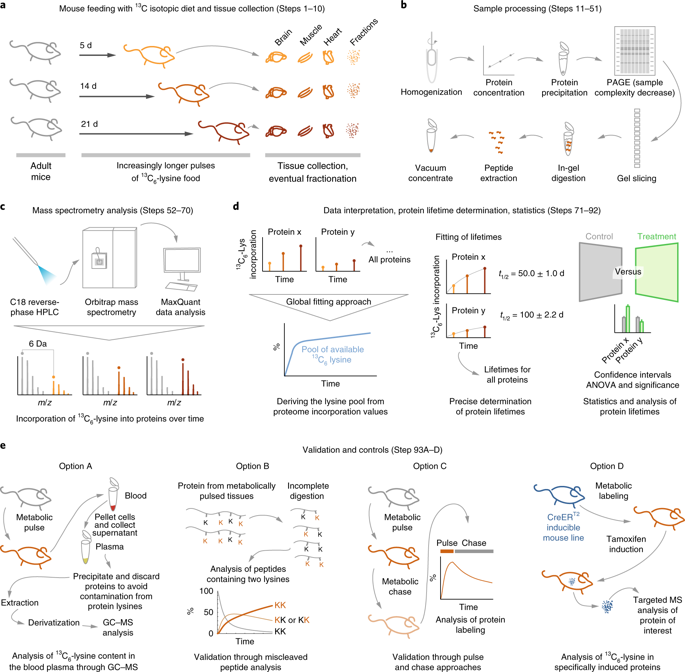当前位置:
X-MOL 学术
›
Nat. Protoc.
›
论文详情
Our official English website, www.x-mol.net, welcomes your feedback! (Note: you will need to create a separate account there.)
A mass spectrometry workflow for measuring protein turnover rates in vivo.
Nature Protocols ( IF 14.8 ) Pub Date : 2019-11-04 , DOI: 10.1038/s41596-019-0222-y Mihai Alevra 1 , Sunit Mandad 1, 2, 3 , Till Ischebeck 4 , Henning Urlaub 2, 3 , Silvio O Rizzoli 1 , Eugenio F Fornasiero 1
Nature Protocols ( IF 14.8 ) Pub Date : 2019-11-04 , DOI: 10.1038/s41596-019-0222-y Mihai Alevra 1 , Sunit Mandad 1, 2, 3 , Till Ischebeck 4 , Henning Urlaub 2, 3 , Silvio O Rizzoli 1 , Eugenio F Fornasiero 1
Affiliation

|
Proteins are continually produced and degraded, to avoid the accumulation of old or damaged molecules and to maintain the efficiency of physiological processes. Despite its importance, protein turnover has been difficult to measure in vivo. Previous approaches to evaluating turnover in vivo have required custom labeling approaches, involved complex mass spectrometry (MS) analyses, or used comparative strategies that do not allow direct quantitative measurements. Here, we describe a robust protocol for quantitative proteome turnover analysis in mice that is based on a commercially available diet for stable isotope labeling of amino acids in mammals (SILAM). We start by discussing fundamental concepts of protein turnover, including different methodological approaches. We then cover in detail the practical aspects of metabolic labeling and explain both the experimental and computational steps that must be taken to obtain accurate in vivo results. Finally, we present a simple experimental workflow that enables measurement of precise turnover rates in a time frame of ~4-5 weeks, including the labeling time. We also provide all the scripts needed for the interpretation of the MS results and for comparing turnover across different conditions. Overall, the workflow presented here comprises several improvements in the determination of protein lifetimes with respect to other available methods, including a minimally invasive labeling strategy and a robust interpretation of MS results, thus enhancing reproducibility across laboratories.
中文翻译:

用于测量体内蛋白质周转率的质谱工作流程。
蛋白质不断产生和降解,以避免旧分子或受损分子的积累并保持生理过程的效率。尽管它很重要,但蛋白质周转率一直难以在体内测量。以前评估体内营业额的方法需要定制标记方法,涉及复杂的质谱 (MS) 分析,或使用不允许直接定量测量的比较策略。在这里,我们描述了一种用于小鼠定量蛋白质组周转分析的强大协议,该协议基于用于哺乳动物中氨基酸的稳定同位素标记 (SILAM) 的市售饮食。我们首先讨论蛋白质周转的基本概念,包括不同的方法学方法。然后,我们详细介绍了代谢标记的实际方面,并解释了为获得准确的体内结果而必须采取的实验和计算步骤。最后,我们提出了一个简单的实验工作流程,可以在约 4-5 周的时间范围内测量精确的周转率,包括标记时间。我们还提供解释 MS 结果和比较不同条件下的营业额所需的所有脚本。总体而言,此处介绍的工作流程包括在确定蛋白质寿命方面相对于其他可用方法的多项改进,包括微创标记策略和对 MS 结果的可靠解释,从而提高了跨实验室的重现性。
更新日期:2019-11-04
中文翻译:

用于测量体内蛋白质周转率的质谱工作流程。
蛋白质不断产生和降解,以避免旧分子或受损分子的积累并保持生理过程的效率。尽管它很重要,但蛋白质周转率一直难以在体内测量。以前评估体内营业额的方法需要定制标记方法,涉及复杂的质谱 (MS) 分析,或使用不允许直接定量测量的比较策略。在这里,我们描述了一种用于小鼠定量蛋白质组周转分析的强大协议,该协议基于用于哺乳动物中氨基酸的稳定同位素标记 (SILAM) 的市售饮食。我们首先讨论蛋白质周转的基本概念,包括不同的方法学方法。然后,我们详细介绍了代谢标记的实际方面,并解释了为获得准确的体内结果而必须采取的实验和计算步骤。最后,我们提出了一个简单的实验工作流程,可以在约 4-5 周的时间范围内测量精确的周转率,包括标记时间。我们还提供解释 MS 结果和比较不同条件下的营业额所需的所有脚本。总体而言,此处介绍的工作流程包括在确定蛋白质寿命方面相对于其他可用方法的多项改进,包括微创标记策略和对 MS 结果的可靠解释,从而提高了跨实验室的重现性。



























 京公网安备 11010802027423号
京公网安备 11010802027423号